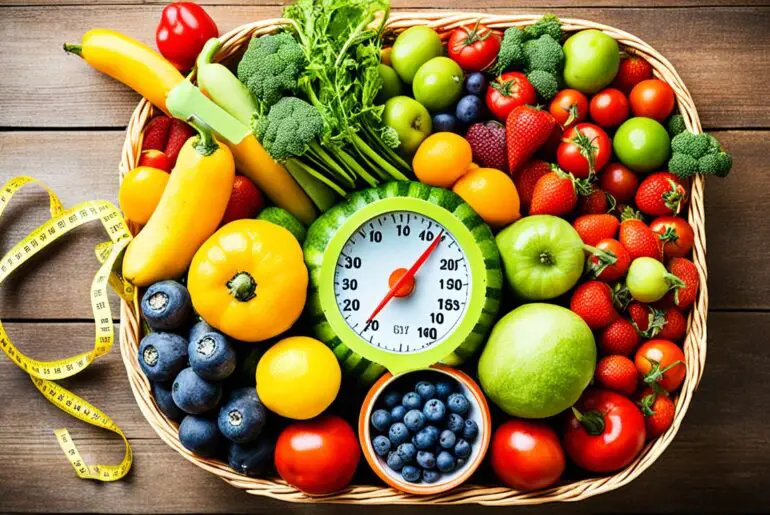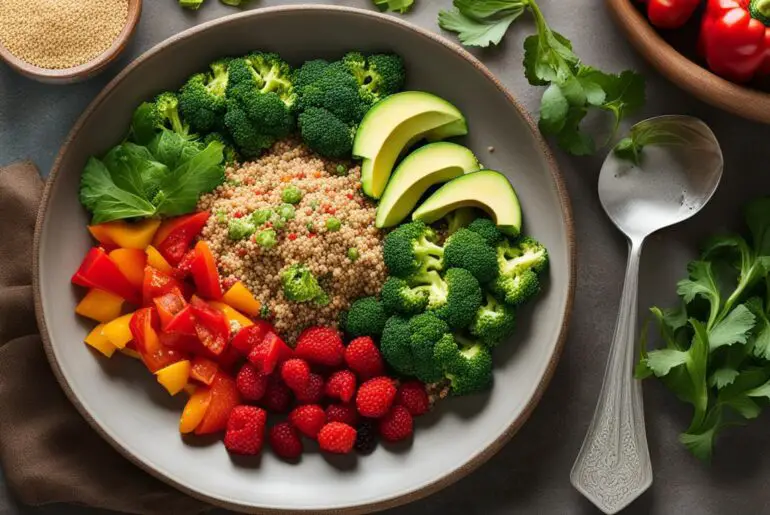Are you looking for healthy meal ideas that fit the HCG diet? If so, you’ve come to the right place. In this article, I will share with you some organic meal ideas that are not only delicious but also suitable for the HCG diet. Whether you’re in the mood for a refreshing salad, a flavorful wrap, or a tasty seafood dish, these meal suggestions will help you stay on track with your weight loss goals while enjoying nutritious and satisfying meals.
When following the HCG diet, it’s important to choose organic food options that are low in calories but high in nutrients. By incorporating organic fruits, vegetables, and lean proteins into your meals, you can ensure that your body is getting the necessary nutrients while on the diet.
Throughout this article, I will provide you with easy HCG diet recipes and organic meal prep ideas that will inspire you to create delicious and healthy meals. Whether you’re a fan of Mexican flavors, crave light and refreshing salads, or prefer flavorful seafood dishes, there’s something here for everyone.
So, are you ready to discover new and exciting organic meal ideas for the HCG diet? Let’s dive in!
Key Takeaways:
- Organic meal ideas can be both satisfying and nutritious for the HCG diet.
- Organic fruits and vegetables contain more nutrients than conventionally grown produce.
- The HCG diet combines hormone injections with a low-calorie meal plan.
- The HCG diet has different phases, including the fat loading phase, diet phase, and maintenance phase.
- Following specific food guidelines during the HCG diet is essential for success.
Benefits of Organic Fruits and Vegetables on the HCG Diet
Organic fruits and vegetables offer numerous benefits when incorporated into the HCG diet. These nutrient-rich foods provide a wide array of vitamins, minerals, and antioxidants that are essential for overall health and effective weight loss.
Research has shown that organic produce often contains higher levels of nutrients compared to conventionally grown counterparts. This is because organic farming practices prioritize soil health, which enhances the nutrient content of fruits and vegetables. By consuming organic options, you can optimize your nutrient intake and support your body’s weight loss efforts.
When selecting organic fruits and vegetables for the HCG diet, aim for a diverse range of colors. Different colors indicate various nutrients, so a colorful plate ensures that you’re getting a wide spectrum of beneficial compounds. Some recommended organic options for the HCG diet include:
- Spinach
- Tomatoes
- Celery
- Swiss chard
- Salad greens
- Cucumbers
- Asparagus
- Cabbage
- Onions
Incorporating these organic fruits and vegetables into your HCG diet meal plan not only adds flavor and variety but also boosts the nutritional value of your meals. The vitamins, minerals, and antioxidants found in organic produce can support your immune system, improve digestion, and enhance your overall well-being.
By choosing organic options, you’re not only benefiting your own health but also supporting sustainable farming practices and reducing exposure to potentially harmful pesticides and chemicals. Prioritizing organic fruits and vegetables on the HCG diet is a wise choice that can contribute to your success and well-being.
Remember to consult with a healthcare professional or registered dietitian before starting any new diet or weight loss plan.
Introduction to the HCG Diet
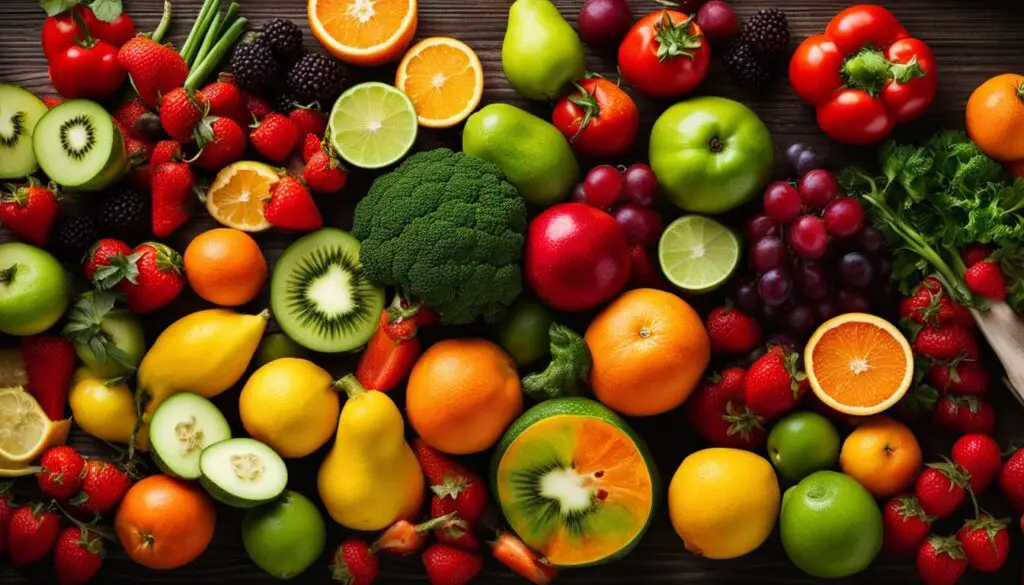
The HCG diet is a popular weight loss program that utilizes the hormone human chorionic gonadotropin (HCG) to promote rapid and effective weight loss. By combining hormone injections with a low-calorie meal plan, the HCG diet offers a unique approach to shedding excess pounds and achieving your weight loss goals.
When receiving hormone injections as part of the HCG diet, the HCG hormone signals your body to tap into its stored abnormal fat for energy, resulting in significant weight loss. This hormone-induced fat burning process helps to prevent hunger pangs and maintain a satisfying meal plan, despite the restricted calorie intake.
The HCG diet typically involves consuming around 500 to 800 calories per day, which is considerably lower than the average daily calorie intake. By following specific guidelines for meals and snacks, you can ensure that you are meeting the nutritional requirements of your body while still creating a calorie deficit that leads to weight loss. The combination of hormone injections and a low-calorie diet makes the HCG diet an effective and efficient weight loss method.
Now, let’s take a closer look at how the HCG diet works and the different phases involved in this weight loss program.
How Does the HCG Diet Work?
The HCG diet works by utilizing the hormone human chorionic gonadotropin (HCG) to promote weight loss. This hormone, which is naturally produced during pregnancy, helps to regulate the metabolic functions of the body and aids in the breakdown of stored fat.
By receiving hormone injections, your body is able to tap into its abnormal fat stores and utilize them for energy and nutrients, resulting in rapid weight loss.
In addition to the hormone injections, the HCG diet also incorporates a low-calorie meal plan. By restricting your daily calorie intake to about 500 to 800 calories, your body is forced to rely on its fat stores for energy, leading to significant weight loss.
The Different Phases of the HCG Diet
The HCG diet consists of several phases, each with its own set of guidelines and dietary restrictions. These phases help to optimize weight loss and ensure long-term success. Let’s take a brief look at each phase:
| Phase | Name | Description |
|---|---|---|
| Phase 1 | Preparation Phase | This phase involves preparing your body for the HCG diet by increasing your consumption of high-fat foods for a couple of days. |
| Phase 2 | Weight Loss Phase | This is the main phase of the HCG diet, where you combine hormone injections with a low-calorie meal plan. |
| Phase 3 | Stabilization Phase | In this phase, you gradually increase your calorie intake and reintroduce more food varieties into your diet. |
| Phase 4 | Maintenance Phase | This final phase focuses on maintaining your weight loss and establishing healthy eating habits for the long term. |
Phase 1: The Fat Loading Phase
The first phase of the HCG diet is the fat loading phase, which lasts for two days. During this phase, you are encouraged to consume high-fat foods to stock up on normal fat cells and prepare your body to burn stored abnormal fat. This phase helps prevent muscle loss and kickstarts the weight loss process.
Common high-fat foods include:
- Eggs
- Avocados
- Butter
- Yogurt
- Nuts
- Seeds
These foods provide the necessary fuel to sustain your body during the next phases of the HCG diet. By incorporating high-fat foods during this phase, you are effectively priming your body to enter a state of ketosis, where it will begin burning stored abnormal fat for energy.
In the fat loading phase, you have the freedom to indulge in high-fat foods which will help your body transition into burning stored abnormal fat.
Phase 2: The Diet Phase

The second phase of the HCG diet is known as the diet phase. During this phase, which typically lasts for 23 to 40 days, you will continue to receive hormone injections or take HCG drops as prescribed. The primary focus of this phase is to follow a strict 500-calorie meal plan. By adhering to this low-calorie diet, you will encourage your body to burn stored abnormal fat for energy, resulting in significant weight loss.
While the restricted calorie intake may seem challenging, it is essential to ensure proper weight loss while maintaining muscle mass. By carefully planning your meals and controlling portion sizes, you can stay within the calorie restriction without feeling deprived.
During the diet phase, there are specific approved foods that you can consume. These include lean proteins such as chicken breast and white fish, non-starchy vegetables like lettuce and tomatoes, and specific fruits. It is important to stick to the approved food list to maintain the effectiveness of the HCG diet and achieve optimal results.
Here is a breakdown of the approved foods for the diet phase:
- Lean Proteins
- Chicken breast
- White fish (tilapia, cod, halibut)
- Lettuce
- Tomatoes
- Cucumbers
- Spinach
- Asparagus
- Broccoli
- Apples
- Oranges
- Strawberries
- Grapefruits
By incorporating these approved foods into your meals, you can create a variety of low-calorie dishes that are still satisfying and delicious. Remember to prioritize portion control and choose cooking methods that minimize added fats and oils.
Throughout the diet phase, it is crucial to stay hydrated and consume plenty of water. Hydration plays a significant role in weight loss and helps flush out toxins from your body.
Stick to the guidelines of the diet phase, and you will be on your way to achieving your weight loss goals while following a structured and nutritious meal plan.
Phase 3: The Maintenance Phase
After completing the diet phase, it’s time to enter the maintenance phase of the HCG diet. This phase is crucial for maintaining your weight loss and ensuring the long-term success of the program. During the maintenance phase, you will focus on gradually reintroducing certain foods, including starches, into your diet. Although you can increase your calorie intake, it’s important to continue following a low-calorie diet to avoid weight regain.
During this phase, you can consume a maximum of 1500 calories per day, which allows for more flexibility while still maintaining the principles of the HCG diet. By gradually reintroducing starches, such as whole grains and legumes, you will provide your body with a steady source of energy and additional nutrients.
The maintenance phase serves several purposes. First, it helps your body adjust to its new weight by stabilizing your metabolism and hormone levels. It allows you to establish healthy eating habits and learn portion control, which are vital for weight maintenance. Additionally, the maintenance phase provides an opportunity to gauge how your body reacts to different foods and identify any potential triggers for weight gain or discomfort.
During this phase, it’s important to monitor your weight regularly and make adjustments to your calorie intake if necessary. If you notice any significant weight gain, you may need to reduce your calorie intake temporarily or increase your physical activity level to find the right balance.
The Reintroduction of Starches
The reintroduction of starches is a gradual process during the maintenance phase. It’s important to reintroduce one type of starch at a time and monitor how your body responds. Start by incorporating small portions of whole grains, such as quinoa or brown rice, into one of your meals. Pay attention to how your body feels and any changes in your weight or energy levels.
If you tolerate the reintroduced starch well, you can gradually increase the portion size or experiment with other starches like potatoes or whole wheat pasta. Remember to maintain portion control and balance your starch intake with lean proteins, non-starchy vegetables, and healthy fats.
It’s worth noting that some individuals may find that their bodies are more sensitive to certain starches or foods even after completing the maintenance phase. If you notice any adverse reactions or weight gain, it may be necessary to adjust your diet and avoid specific foods that don’t agree with your body.
The maintenance phase is an essential part of the HCG diet journey as it sets the foundation for long-term weight maintenance. By gradually reintroducing starches and monitoring your body’s response, you can find a sustainable eating plan that works for you.
Benefits of the Maintenance Phase
- Helps stabilize your metabolism and hormone levels
- Allows you to establish healthy eating habits and portion control
- Provides an opportunity to identify food triggers for weight gain
- Allows for gradual reintroduction of starches and other foods
- Sets the foundation for long-term weight maintenance
Food Guidelines for Phase 2 of the HCG Diet

During phase 2 of the HCG diet, it is essential to follow specific food guidelines to maximize your success. By incorporating approved foods into your meal plan, such as fruits, vegetables, and lean proteins, you can ensure that you are consuming a balanced and nutritious diet while on the HCG diet.
Approved Foods
- Fruits: Oranges, strawberries, and apples are excellent fruit choices for the HCG diet. These fruits provide natural sweetness and a variety of vitamins and minerals to support your overall health.
- Non-Starchy Vegetables: Spinach, celery, and cucumbers are just a few examples of non-starchy vegetables that you can enjoy on the HCG diet. These vegetables are low in calories, high in fiber, and packed with essential nutrients.
- Lean Proteins: As a vital component of the HCG diet, lean proteins like chicken breast and white fish are recommended. These protein sources are low in fat and rich in essential amino acids to support muscle health and satiety.
It is important to note that starchy vegetables, fatty foods, and processed foods are not allowed during phase 2 of the HCG diet. By eliminating these foods, you can optimize your weight loss results and maintain a healthy eating pattern.
By following these food guidelines, you can create delicious and satisfying meals that align with the HCG diet principles. Remember to consult with a healthcare professional before starting any weight loss program to ensure it is suitable for your individual needs and health status.
HCG Diet Recipes: Mexican-Style Turkey Lettuce Wraps
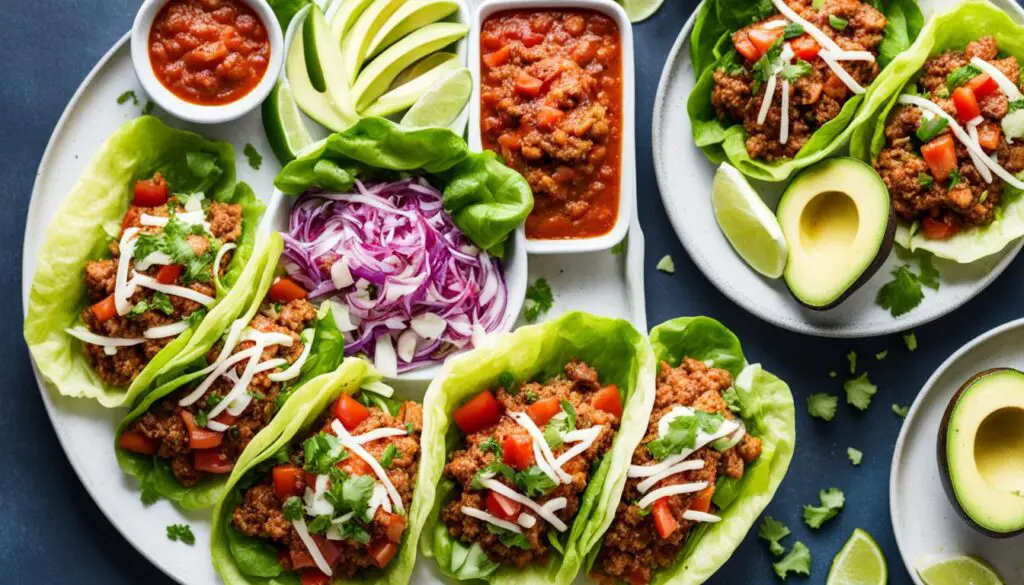
Incorporating flavorful Mexican-inspired spices, these Mexican-Style Turkey Lettuce Wraps are a perfect addition to the HCG diet. By using lean ground turkey combined with a variety of herbs and spices, this recipe provides a burst of flavor without adding unnecessary calories. The lettuce wraps replace traditional tortillas, offering a low-calorie alternative that keeps your meal light and satisfying. It’s a delicious option for those seeking variety in their HCG diet meal plan.
Here’s what you’ll need to create these mouthwatering Mexican-Style Turkey Lettuce Wraps:
- Ground turkey
- Diced onions and tomatoes
- Garlic
- Cumin
- Smoked paprika
- Chili powder
- Turmeric
- Lettuce leaves
- Fresh cilantro
- Lime wedges
With these simple ingredients in hand, you’ll be able to prepare a delicious and satisfying meal that is quick and easy to make. These Mexican-Style Turkey Lettuce Wraps can be enjoyed for multiple meals, making them a convenient option for those following the HCG diet.
For the detailed instructions on how to prepare this recipe, refer to the table below:
| Ingredients | Instructions |
|---|---|
| Ground turkey | 1. Heat a non-stick skillet over medium heat. |
| Diced onions and tomatoes | 2. Add the diced onions and tomatoes to the skillet and cook until softened. |
| Garlic | 3. Stir in the garlic, cumin, smoked paprika, chili powder, and turmeric. Cook for an additional 2 minutes. |
| Lettuce leaves | 4. Wash and dry the lettuce leaves, then set them aside. |
| Fresh cilantro | 5. Remove the skillet from heat and stir in the fresh cilantro. |
| Lime wedges | 6. Serve the seasoned ground turkey mixture in the lettuce leaves, garnishing with lime wedges on the side. |
These Mexican-Style Turkey Lettuce Wraps are a delicious way to incorporate lean proteins and vibrant flavors into your HCG diet. The combination of the turkey and Mexican-inspired spices creates a satisfying meal that will keep you on track with your weight loss goals. Enjoy the freshness and boldness of these wraps while sticking to your low-calorie meal plan.
HCG Diet Recipes: Tomato-Cilantro Salad
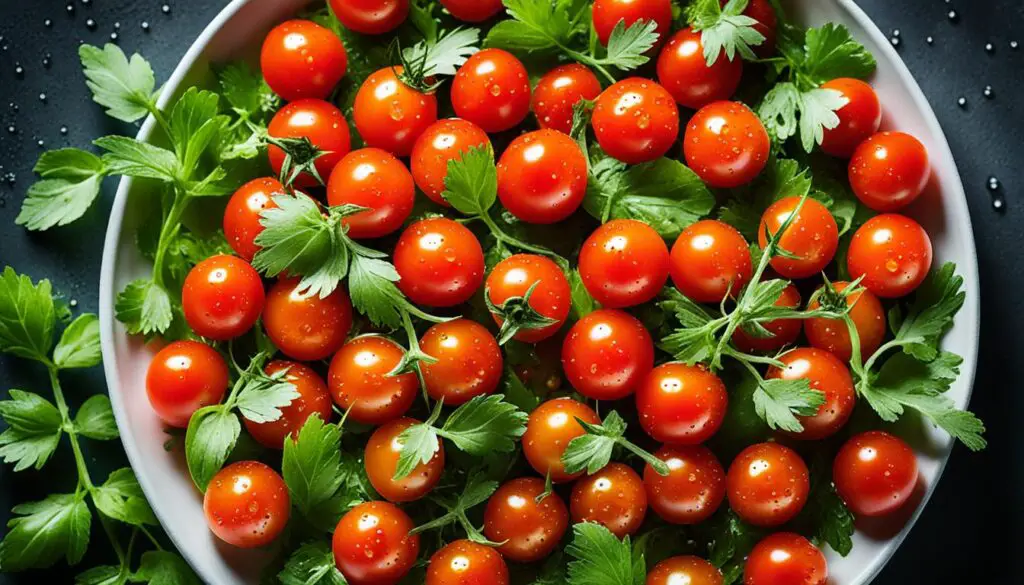
This refreshing tomato-cilantro salad is a perfect addition to your HCG diet meal plan. It can be enjoyed alongside the Mexican-style turkey lettuce wraps or as a standalone dish. Packed with flavorful ingredients, this salad is both nutritious and low in calories.
The ingredients for this low-calorie vegetable dish include fresh tomatoes, sherry vinegar, red onion, lime juice, celery, garlic, cumin, smoked paprika, chili powder, turmeric, and fresh cilantro. These ingredients come together to create a vibrant and tangy salad that will satisfy your taste buds.
To prepare this delicious salad, start by chopping the tomatoes and red onion into small pieces. In a bowl, whisk together sherry vinegar, lime juice, minced garlic, cumin, smoked paprika, chili powder, and turmeric. Add the chopped tomatoes, red onion, and celery to the bowl and toss to coat the vegetables with the dressing. Finally, garnish the salad with fresh cilantro leaves.
This tomato-cilantro salad is not only a tasty side dish but also a great source of essential vitamins and minerals. Tomatoes are rich in lycopene, which has been linked to various health benefits, including heart health and cancer prevention. Cilantro, on the other hand, adds a burst of flavor and is a good source of antioxidants.
Whether you’re looking for a refreshing side dish or a light lunch option, this tomato-cilantro salad is a fantastic choice. Its vibrant flavors and nutrient-packed ingredients make it an ideal addition to your HCG diet meal plan.
HCG Diet Recipes: Baked Chili-Asian Tilapia with Cucumber Salad
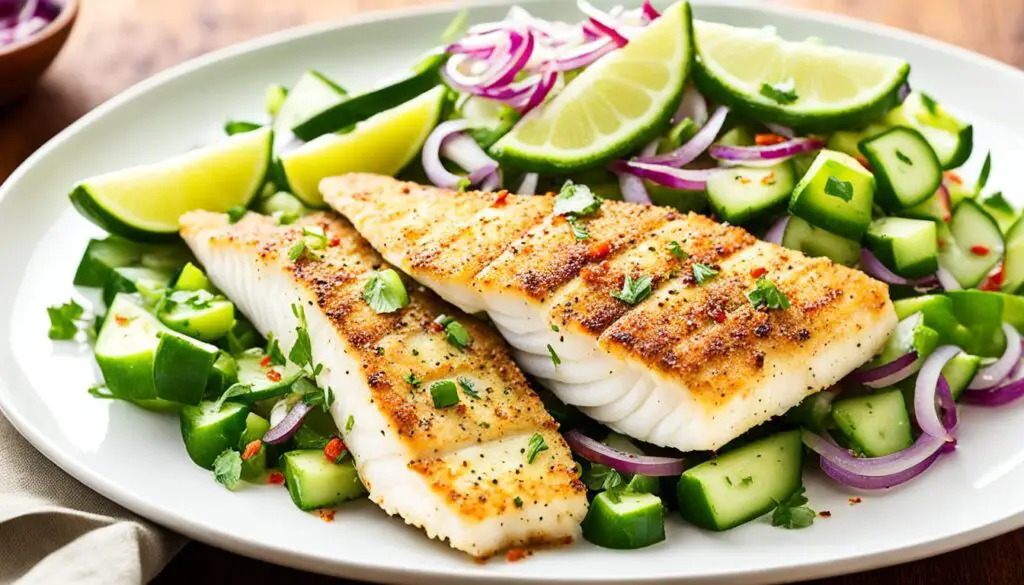
Looking for a flavorful and low-calorie seafood dish for your HCG diet? Try this delicious recipe for Baked Chili-Asian Tilapia with Cucumber Salad. The Asian-inspired flavors of chili powder, smoked paprika, turmeric, ginger, garlic, and cilantro elevate the mildness of tilapia, creating a delightful culinary experience. Paired with a refreshing cucumber salad, this dish is light, nutritious, and perfect for those following the HCG diet.
Here’s what you’ll need:
- 4 tilapia fillets
- 1 teaspoon chili powder
- 1 teaspoon smoked paprika
- 1/2 teaspoon turmeric
- 1/2 teaspoon ground ginger
- 2 cloves garlic, minced
- 2 tablespoons chopped fresh cilantro
- 4 cucumbers, thinly sliced
- 2 tablespoons soy sauce
- 2 tablespoons rice vinegar
- 1/4 teaspoon smoked paprika
- 2 tablespoons chopped fresh cilantro
Instructions:
- Preheat your oven to 375°F (190°C).
- In a small bowl, combine the chili powder, smoked paprika, turmeric, ground ginger, minced garlic, and chopped cilantro.
- Place the tilapia fillets on a baking dish lined with parchment paper.
- Sprinkle the spice mixture evenly over the tilapia.
- Bake the tilapia in the preheated oven for 12-15 minutes, or until it is firm and opaque.
- While the tilapia is baking, prepare the cucumber salad by combining the sliced cucumbers, soy sauce, rice vinegar, smoked paprika, and chopped cilantro in a bowl.
- Toss the cucumber salad gently to coat the cucumbers with the dressing.
- Remove the tilapia from the oven and serve it with the cucumber salad.
- Garnish with additional cilantro if desired.
Enjoy this flavorful and satisfying seafood dish that fits perfectly into your HCG diet meal plan. The combination of the baked chili-asian tilapia and the refreshing cucumber salad will leave your taste buds craving for more. Bon appétit!
Note: Always consult with a medical professional before starting any weight loss program, including the HCG diet.
Conclusion
The HCG diet offers a unique and effective approach to weight loss by combining hormone injections with a low-calorie meal plan. By following the phases and guidelines of this diet, individuals can achieve rapid weight loss while still enjoying satisfying and nutritious meals.
Throughout this article, we have explored organic meal ideas that can add variety and flavor to your HCG diet journey. Incorporating organic fruits, vegetables, and lean proteins ensures that you are getting essential nutrients while on the diet.
It is important to remember that before starting any weight loss program, including the HCG diet, it is advisable to consult with a medical professional. They can provide personalized guidance and ensure the diet is suitable for your specific health needs.
FAQ
What is the HCG diet?
The HCG diet is a weight loss plan that combines the hormone HCG with a low-calorie meal plan.
Why should I choose organic fruits and vegetables on the HCG diet?
Organic fruits and vegetables have been shown to have more nutrients than conventionally grown produce, providing important vitamins, minerals, and antioxidants for your overall health and weight loss.
What are the phases of the HCG diet?
The HCG diet consists of three phases: the fat loading phase, the diet phase, and the maintenance phase.
What is the purpose of the fat loading phase?
The fat loading phase aims to stock up on normal fat cells to prepare your body to burn stored abnormal fat, preventing muscle loss and kickstarting the weight loss process.
What foods are approved during the diet phase of the HCG diet?
Approved foods during the diet phase include lean proteins, non-starchy vegetables, and specific fruits. Starchy vegetables, fatty foods, and processed foods are not allowed.
What is the purpose of the maintenance phase?
The maintenance phase focuses on maintaining your weight loss and gradually reintroducing starches into your diet while following a low-calorie intake.
What are the food guidelines for phase 2 of the HCG diet?
During phase 2, you should consume approved fruits, non-starchy vegetables, and lean proteins while avoiding starchy vegetables, fatty foods, and processed foods.
Can you provide an HCG diet recipe?
Sure! Here’s a recipe for Mexican-Style Turkey Lettuce Wraps that is HCG diet-friendly.
Can you provide another HCG diet recipe?
Of course! Here’s a recipe for a refreshing Tomato-Cilantro Salad that complements your HCG diet meal plan.
Absolutely! Try this Baked Chili-Asian Tilapia with Cucumber Salad recipe for a light and flavorful option on the HCG diet.
What should I be aware of when following the HCG diet?
Always consult with a medical professional before starting any weight loss program, including the HCG diet.


